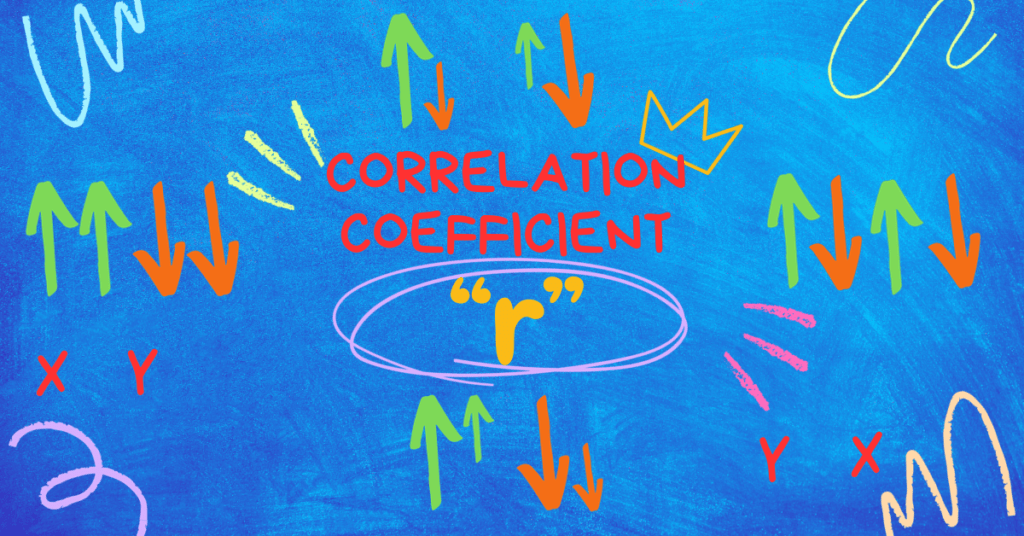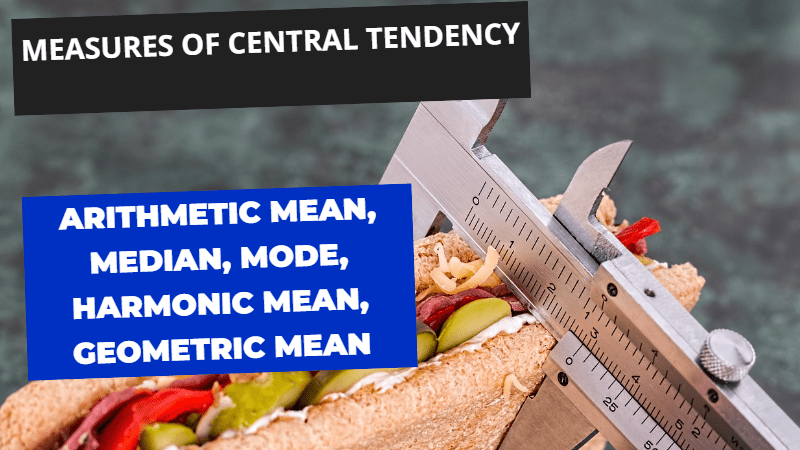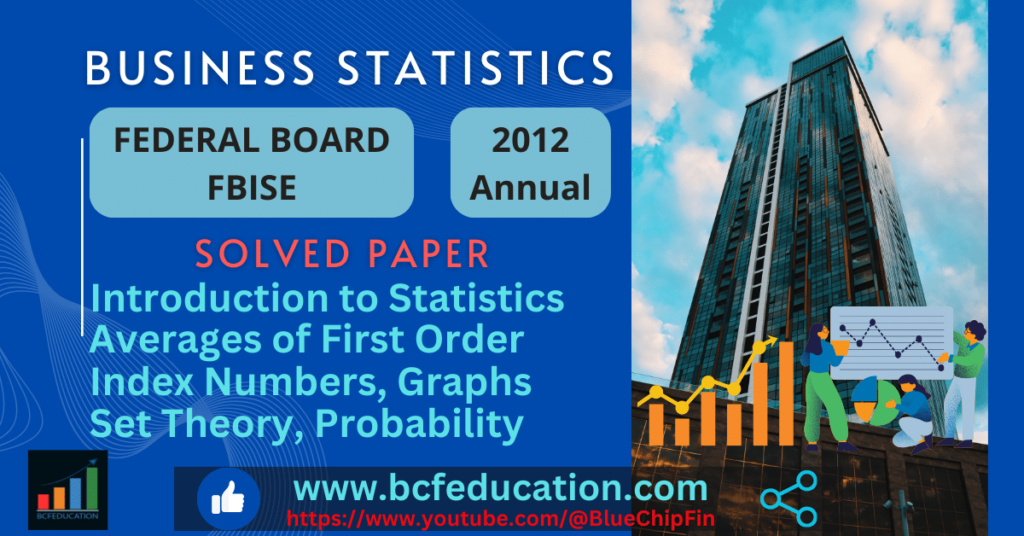Solved Paper Statistics I FBISE 2011, Dive into a comprehensive solution guide to the FBISE Statistics I 2011 paper! This blog post provides detailed explanations and step-by-step solutions for key topics like measures of central tendency, dispersion, data presentation, index numbers, correlation, regression, and time series. Whether you’re preparing for exams or reinforcing your understanding, this post is tailored to simplify concepts and help you excel in statistics. This topic is equally important for the students of statistics across all the major Boards and Universities such as FBISE, BISERWP, BISELHR, MU, DU, PU, NCERT, CBSE & others & across all the statistics, business & finance disciplines.
Table of Contents
Solved Paper Statistics I FBISE 2011
Q.1 Circle the Correct Option i.e. A/B/C/D. Each Part Carries 1 Mark.
| Q.1 Circle the Correct Option i.e. A/B/C/D. Each Part Carries 1 Mark. | ||||
| (i) | The data which have already been collected by someone are called_______ data. | |||
| A | Secondary | B | Primary | |
| C | Array | D | None of these | |
| (ii) | The number 143.9500 rounded off to the nearest tenth (one decimal place) is: | |||
| A | 143.9 | B | 144.0 | |
| C | 143.0 | D | 144 | |
| (iii) | Weight of the earth is: | |||
| A | Discrete variable | B | Qualitative variable | |
| C | Continuous Variable | D | Difficult to tell | |
| (iv) | The budgets of two families can be compared by: | |||
| A | Sub divided rectangles | B | Pie-diagram | |
| C | Both A & B | D | Histogram | |
| (v) | A relative frequency distribution presents frequencies in terms of: | |||
| A | Fractions | B | Whole Numbers | |
| C | Percentage | D | None of these | |
| (vi) | If X̅ = 25, which of the following will be minimum? | |||
| A | ∑(X – 27)² | B | ∑(X – 25)² | |
| C | ∑(X – 22)² | D | ∑(X + 25)² | |
| (vii) | Harmonic mean for any two positive numbers a and b is: | |||
| A | | B | | |
| C | | D | | |
| (viii) | To compare the variation of two or more than two series, we use: | |||
| A | Mean absolute variation | B | Variance | |
| C | Coefficient of variation | D | Corrected standard deviation | |
| (ix) | In a symmetrical distribution if Q1 = 4, Q3 = 12 then median is: | |||
| A | 4 | B | 6 | |
| C | 8 | D | Zero | |
| (x) | The first three moments of a distribution about the mean X̅ are 1, 4 and 0. The distribution is: | |||
| A | Symmetrical | B | Skewed to left | |
| C | Skewed to the right | D | Normal | |
| (xi) | The distribution is positively skewed if: | |||
| A | Arithmetic Mean < Mode | B | Arithmetic Mean > Mode | |
| C | Arithmetic Mean > Median | D | Both B and C | |
| (xii) | _________method is uses quantities consumed in the base period when computing a weighted index: | |||
| A | Laspeyre’s | B | Paasche’s | |
| C | Fisher’s | D | None of these | |
| (xiii) | Prices used in the construction of consumer price index number are______prices. | |||
| A | Retail | B | Wholesale | |
| C | The fixed | D | None of these | |
| (xiv) | The mean of 10 observations is 10. All observations are increased by 10%. The mean of the increased observations shall be: | |||
| A | 20 | B | 11 | |
| C | 10 | D | 100 | |
| (xv) | If all the actual and estimated values of y are the same on the regression line, the sum of squares of errors will be: | |||
| A | 0 | B | 11 | |
| C | 10 | D | 100 | |
| (xvi) | The value of the coefficient of correlation lies between: | |||
| A | 0 and 1 | B | 0 and -1 | |
| C | -1 and +1 | D | -2 and +2 | |
| (xvii) | In time series a business cycle has: | |||
| A | One phase | B | Two phases | |
| C | Four Phases | D | Three Phases | |
Short Question
SECTION-B
Q.2 Attempt any fourteen parts.
(i) Differentiate between descriptive & Inferential Statistics.
Answer:
Descriptive Statistics
Descriptive statistics is a branch of statistics in which data is presented in the form of tables, graphs and charts. Measures of central tendency and dispersion is also a part of descriptive statistics. The aim of descriptive statistics is to present the data in informative way.
Example: Teacher gathering data of student’s marks, calculates averages, variation and presenting in graph.
Inferential Statistics
Inferential statistics is also a branch of statistics in which sample data is used to predict about population. Inferential statistics is used to predict the future trend and fluctuations. Key functions of inferential statistics is to make hypothesis, regression analysis etc.
(ii) What are the functions of statistics?
Answer:
Statistics play important role across different fields all around the world. Its key functions are given below:
Data Collection: Gathering data through surveys, Questionnaires, Researches.
Data Organization: Organizing raw data into organized form for further analysis.
Data Summarization: Calculate Central Tendencies and dispersion for meaningful insight.
Data Interpretation: Making pattern and trends from the data analysis and draw conclusions.
Data Comparison: Make data comparison through cross tabulation of ANOVA and hypothesis.
Prediction and Forecasting: To predict the future prediction and trends through inferential statistics.
Decision Making: Making timely decision with the help of data.
Quality Control: Ensuring quality control through using data techniques.
Customer Relationship: Statistics is a key tool to know the customer taste, demand and trends to make better relationship with customer.
(iii) What are the common types of frequency distribution?
Answer:
- Grouped frequency distribution
- Ungrouped frequency distribution
- Cumulative frequency distribution
- Relative frequency distribution
- Cumulative frequency distribution
(iv)Differentiate between Historigram and Histogram.
Answer:
Histogram is a graph of frequency distribution in which class boundaries with suitable width is taken on X-axis where as respective frequencies are taken on Y-axis. In Histogram relative frequencies are shown in the shape of adjacent rectangular bars.
Whereas graph of Time Series or historical series is called historigram.
(v) A given stock was purchased at the following prices at various times, 20 shares at Rs. 8.20 a share, 100 shares at Rs 10.90 a share, 50 shares at Rs. 9.40 a share and 200 shares at Rs. 7.80 a share. Find the mean cost per share.
Solution:
Data
| Shares | Per unit price | Total price |
| 20 | 8.20 Per share | 164 |
| 100 | 10.90 Per share | 1090 |
| 50 | 9.40 Per share | 470 |
| 200 | 7.80 per share | 1560 |
| Total Shares = 370 = n | ∑x = 3284 |
![]()
(vi) The mean and geometric mean of three numbers are 7 and 4, respectively. Find all the three numbers if mean of two numbers is 10.
Solution:
Let the three numbers be a, b, c, and if mean of two numbers is 10, then:
![]()
![]()
![]()
![]()
![]()
![]()
![]()
![]()
Take equation i & ii & get c
a + b = 20 (i)
a + b + c = 21 (ii)
C = 1
If c = 1 then ab = 64
ab = 64
⟹a (20−a) =64
⟹20a – a² – 64= 0
⟹a2−20a+64=0
⟹ (a−16) (a−4) =0
⟹ {a,b,c}={16,4,1}
(vii) What are the desirable qualities of a good average?
Answer:
(1) It should be easy to calculate and simple to understand.
(2) It should be clearly defined by a mathematical formula.
(3) It should not be affected by extreme values.
(4) It should be based on all the observations.
(5) It should be capable of further mathematical treatment.
(6) It should have sample stability.
(viii) The first four moments about X = 17.5 of a distribution are 0.3, 74, 45 and 12125. Find whether the distribution is leptokurtic or Platykurtic.
Solution:
![]()
![]()
(ix) Given: Calculate Median, Mode, Q3 and D7.
Given:
| No. of Children | 0 | 1 | 2 | 3 | 4 | 5 |
| No. of families | 4 | 7 | 14 | 22 | 12 | 6 |
Calculate Median, Mode, Q3 and D7.
Solution:
| No. of Children (X) | No. of Families (f) | C.f |
| 0 | 4 | 4 |
| 1 | 7 | 11 |
| 2 | 14 | 25 |
| 3 | 22 | 47 |
| 4 | 12 | 59 |
| 5 | 6 | 65 |
![]()
![]()
![]()
![]()
(x) Given n1=15, n2 = 25, n3 = 40, X̅1=15.8, X̅2=22.5, X̅3=30.2, S1=2.45, S2 = 4.65, S3 = 7.28. Compute combined coefficient of variation.
Solution
| X̅1 = 15.8, n1 = 15, S1=2.45, S1² = 6 |
| X̅2 = 22.5, n2 = 25, S2=4.65, S2² = 21.6225 |
| X̅3 = 30.2, n3 = 40, S3=7.28, S3² = 52.9984 |
![]()
![]()
![]()
![]()
Combined Variance
![]()
![]()
![]()
![]()
![]()
![]()
![]()
![]()
(xi) What will be the standard deviation and the variance in each of the following case? (i) 2X (ii) X + 2 (iii) 2X + 4 if Var(X) = 25
Solution:
(i) 2X
![]()
![]()
![]()
(ii) X + 2
![]()
![]()
![]()
(iii) 2X + 4
![]()
![]()
![]()
(xii) Compute chain index taking 1920 as base for the following data:
| Year | 1920 | 1921 | 1922 | 1923 | 1924 | 1925 | 1926 | 1927 | 1928 | 1929 | 1930 |
| Price Relative | 100 | 116 | 120 | 120 | 137 | 136 | 149 | 156 | 137 | 162 | 149 |
Solution:
| Year | Price Relative | Link Relative = | |
| 1920 | 100 | 100 | 100 |
| 1921 | 116 | (116/100)×100=116 | (100×116)/100=116 |
| 1922 | 120 | (120/116)×100=103.44 | (116×103.44)/100=119.99 |
| 1923 | 120 | (120/120)×100=100 | (119.99×100)/100=119.99 |
| 1924 | 137 | (137/120)×100=114.17 | (119.99×114.17)/100=136.99 |
| 1925 | 136 | (136/137)×100=99.27 | (136.99×99.27)/100=135.98 |
| 1926 | 149 | (149/136)×100=109.55 | (135.98×109.55)/100=148.96 |
| 1927 | 156 | (156/149)×100=104.69 | (148.96×104.69)/100=155.94 |
| 1928 | 137 | (137/156)×100=87.82 | (155.94×87.82)/100=136.94 |
| 1929 | 162 | (162/137)×100=118.24 | (136.94×118.24)/100=161.91 |
| 1930 | 149 | (149/162)×100=91.97 | (161.91×91.97)/100=148.90 |
(xiii) What are the important uses of index number?
Answer:
- Index numbers are used in the fields of commerce, meteorology, labour, industrial, etc.
- The index numbers measure fluctuations during intervals of time, group differences of geographical position of degree etc.
- They are used to compare the total variations in the prices of different commodities in which the unit of measurements differs with time and price etc.
- They measure the purchasing power of money.
- They are helpful in forecasting the future economic trends.
- They are used in studying difference between the comparable categories of animals, persons or items.
- Index numbers of industrial production are used to measure the changes in the level of industrial production in the country.
- Index numbers of import prices and export prices are used to measure the changes in the trade of a country.
- The index numbers are used to measure seasonal variations and cyclical variations in a time series.
(xiv) Given the following information: Compute Base year weighted & current year weighted price index numbers.
![]()
Solution
![]()
![]()
![]()
![]()
(xv) What is meant by regression?
Answer:
Regression calculates the relationship between one dependent variables and one or more independent variables. Regression shows the effect of one unit change in an independent variable on the dependent variable.
(xvi) Given n = 10, ∑Dx = – 8, ∑Dy = 0, ∑D²x = 66, ∑D²y = 99, ∑DxDy = 72. Find r, bxy, byx.
Solution:
![Rendered by QuickLaTeX.com \[ rxy = \ \frac{\sum DxDy - \ \frac{(\sum Dx)(\sum Dy)}{n}}{\sqrt{\left\lbrack \left{ \sum Dx^{2} - \frac{(\sum Dx)^{2}}{n} \right}\left{ \sum Dy^{2} - \frac{(\sum Dy)^{2}}{n} \right} \right\rbrack}}\ \]](https://bcfeducation.com/wp-content/ql-cache/quicklatex.com-c359fa1ee1d9bc1d49ce056c460b1e82_l3.png)
![Rendered by QuickLaTeX.com \[ rxy = \ \frac{72 - \ \frac{( - 8)(0)}{10}}{\sqrt{\left\lbrack \left{ 66 - \frac{( - 8)^{2}}{10} \right}\left{ 99 - \frac{(0)^{2}}{10} \right} \right\rbrack}}\ \]](https://bcfeducation.com/wp-content/ql-cache/quicklatex.com-27676560648344d0bf9f497ee328d95b_l3.png)
![]()
![Rendered by QuickLaTeX.com \[ byx = \ \frac{\sum DxDy - \ \frac{(\sum Dx)(\sum Dy)}{n}}{\left( \sum Dx^{2} - \frac{(\sum Dx)^{2}}{n} \right)}\ \]](https://bcfeducation.com/wp-content/ql-cache/quicklatex.com-898f8d612975f2edc43f1a081b2ce947_l3.png)
![]()
![]()
![]()
![]()
![Rendered by QuickLaTeX.com \[ bxy = \ \frac{\sum DxDy - \ \frac{(\sum Dx)(\sum Dy)}{n}}{\left( \sum Dy^{2} - \frac{(\sum Dy)^{2}}{n} \right)}\ \]](https://bcfeducation.com/wp-content/ql-cache/quicklatex.com-debf9365f2bd700bd187b4f4e009f9f7_l3.png)
![]()
![]()
![]()
![]()
(xvii) Differentiate between Signal and Noise
Answer:
A variation in any time series caused by sequence of systematic components is called “Signal” whereas A variation in any time series caused by sequence of unsystematic components is called “Noise”

(xviii) Fit a straight line to the following results for the years 1951-58 both inclusive ∑x = 0, ∑y = 2861.1, ∑x² = 168, ∑xy = 2215.5. Also compute trend values.
Solution:
Data:
∑x = 0, ∑y = 2861.1, ∑x² = 168, ∑xy = 2215.5, n = 8
Ŷ = a + bx
![]()
![]()
![]()
Ŷ = a + bx
Ŷ = 357.6375 + 13.1875x
Calculation of Trend Values
| Year | X | Ŷ = 357.6375 + 13.1875x |
| 1951 | -7 | Ŷ = 357.6375 + 13.1875(-7) = 265.325 |
| 1952 | -5 | Ŷ = 357.6375 + 13.1875(-5) = 291.7 |
| 1953 | -3 | Ŷ = 357.6375 + 13.1875(-3) = 318.075 |
| 1954 | -1 | Ŷ = 357.6375 + 13.1875(-1) = 344.45 |
| 1955 | +1 | Ŷ = 357.6375 + 13.1875(1) = 370.825 |
| 1956 | +3 | Ŷ = 357.6375 + 13.1875(3) = 397.2 |
| 1957 | +5 | Ŷ = 357.6375 + 13.1875(5) = 423.575 |
| 1958 | +7 | Ŷ = 357.6375 + 13.1875(7) = 449.95 |
(xix) Find 4-years moving averages cantered from the following data:
| Year | 1990 | 1991 | 1992 | 1993 | 1994 | 1995 | 1996 |
| Y | 45 | 88 | 65 | 59 | 95 | 81 | 788 |
Solution:
| Year | Values | 4 Years Moving Total | 2 Values Moving Total | 4 Years Centered Moving Average |
| 1990 | 45 | |||
| 1991 | 88 | |||
| 257 | ||||
| 1992 | 65 | 564 | 70.5 | |
| 307 | ||||
| 1993 | 59 | 607 | 75.875 | |
| 300 | ||||
| 1994 | 95 | 1323 | 165.375 | |
| 1023 | ||||
| 1995 | 81 | |||
| 1996 | 788 |

Extensive Questions
Q.3 Calculate: (i) Mean Deviation from Median, (ii) Coefficient of Variation. From the following frequency distribution:
| Max: Load (Short tons) | No of cables |
| 9.3—9.7 | 2 |
| 9.8—10.2 | 5 |
| 10.3—10.7 | 12 |
| 10.8—11.2 | 17 |
| 11.3—11.7 | 14 |
| 11.8—12.2 | 6 |
| 12.3—12.7 | 3 |
| 12.8—13.2 | 1 |
Solution:
| Max: Load (Short tons) | No of cables (f) | Class Boundaries | X | fX | fX² | C.f | |X-median| | f|X-median| |
| 9.3—9.7 | 2 | 9.25—9.75 | 9.5 | 19 | 180.5 | 2 | 1.57 | 3.14 |
| 9.8—10.2 | 5 | 9.75—10.25 | 10 | 50 | 500 | 7 | 1.07 | 5.35 |
| 10.3—10.7 | 12 | 10.25—10.75 | 10.5 | 126 | 1323 | 19 | 0.57 | 6.84 |
| 10.8—11.2 | 17 | 10.75—11.25 | 11 | 187 | 2057 | 36 | 0.07 | 1.19 |
| 11.3—11.7 | 14 | 11.25—11.75 | 11.5 | 161 | 1851.5 | 50 | 0.43 | 6.02 |
| 11.8—12.2 | 6 | 11.75—12.25 | 12 | 72 | 864 | 56 | 0.93 | 5.58 |
| 12.3—12.7 | 3 | 12.25—12.75 | 12.5 | 37.5 | 468.75 | 59 | 1.43 | 4.29 |
| 12.8—13.2 | 1 | 12.75—13.25 | 13 | 13 | 169 | 60 | 1.93 | 1.93 |
| 60 | 665.5 | 7413.75 | 34.34 | |||||
| ∑f= | ∑fX= | ∑fX²= | ∑f|X-median| = |
![]()
![]()
![]()
![]()
![]()
![Rendered by QuickLaTeX.com \[ S.D = \ \sqrt{\left\lbrack \frac{\sum fx^{2}}{\sum f} - \ \left( \frac{\sum fx}{\sum f} \right)^{2} \right\rbrack}\ \]](https://bcfeducation.com/wp-content/ql-cache/quicklatex.com-b7d3ebbe9f0e0a83630f513896a7df4a_l3.png)
![Rendered by QuickLaTeX.com \[ S.D = \sqrt{\left\lbrack \frac{7413.75}{60} - \ \left( \frac{665.5}{60} \right)^{2} \right\rbrack}\ \]](https://bcfeducation.com/wp-content/ql-cache/quicklatex.com-bf6f41e041488eb7a5c4456df97e0289_l3.png)
![]()
![]()
![]()
![]()
![]()
![]()
![]()
Q.4 Construct Consumer Price Index of 1980 on the basis of 1978 using: (i) Aggregative Method (ii) Family Budget Method
| Articles | Quantity Consumed | Unit of Price | Prices (Rs.) | |
| 1978 | 1980 | |||
| Rice | 6 maunds | Per Seer | 6 | 6.50 |
| Wheat | 10 maunds | Per maund | 35 | 40 |
| Grain | 3 maunds | Per maund | 60 | 90 |
| Pulses | 5 maunds | Per maund | 120 | 144 |
| Ghee | 5 Seers | Per Seer | 8 | 10 |
| Sugar | 1 maund | Per maund | 240 | 300 |
Solution:
| Unit of Price | Article | Quantity Consumed (qo) | Prices (Rs.) | P1qo | poqo = W | I=(P1/Po) × 100 | WI | |
| 1978(Po) | 1980(P1) | |||||||
| Per Seer(6×40) | Rice | 240 | 6 | 6.5 | 1560 | 1440 | 108.33333 | 156000 |
| Per maund | Wheat | 10 | 35 | 40 | 400 | 350 | 114.28571 | 40000 |
| Per maund | Grain | 3 | 60 | 90 | 270 | 180 | 150 | 27000 |
| Per maund | Pulses | 5 | 120 | 144 | 720 | 600 | 120 | 72000 |
| Per Seer | Ghee | 5 | 8 | 10 | 50 | 40 | 125 | 5000 |
| Per maund | Sugar | 1 | 240 | 300 | 300 | 240 | 125 | 30000 |
| 3300 | 2850 | 742.61905 | 330000 | |||||
| ∑p1qo= | ∑poqo= | ∑I= | ∑WI= | |||||
![]()
![]()
![]()
![]()
![]()
![]()
Q.5 The following table shows the ages (X) and systolic blood pressure (Y) of 12 women..
| (X) | (Y) |
| 56 | 147 |
| 42 | 125 |
| 72 | 160 |
| 36 | 118 |
| 63 | 149 |
| 47 | 128 |
| 55 | 150 |
| 49 | 145 |
| 38 | 115 |
| 42 | 140 |
| 68 | 152 |
| 60 | 155 |
- Compute Regression line of Y on X & X on Y
- Compute Coefficient of Correlation between X & Y.
- Show that
![Rendered by QuickLaTeX.com \[ r = \ \sqrt{byx\ .bxy}\ \]](data:image/svg+xml;base64,PHN2ZyB4bWxucz0iaHR0cDovL3d3dy53My5vcmcvMjAwMC9zdmciIHdpZHRoPSIxMDAiIGhlaWdodD0iMTgiIHZpZXdCb3g9IjAgMCAxMDAgMTgiPjxyZWN0IHdpZHRoPSIxMDAlIiBoZWlnaHQ9IjEwMCUiIHN0eWxlPSJmaWxsOiNjZmQ0ZGI7ZmlsbC1vcGFjaXR5OiAwLjE7Ii8+PC9zdmc+)
Solution:
| (X) | (Y) | X² | Y² | XY |
| 56 | 147 | 3136 | 21609 | 8232 |
| 42 | 125 | 1764 | 15625 | 5250 |
| 72 | 160 | 5184 | 25600 | 11520 |
| 36 | 118 | 1296 | 13924 | 4248 |
| 63 | 149 | 3969 | 22201 | 9387 |
| 47 | 128 | 2209 | 16384 | 6016 |
| 55 | 150 | 3025 | 22500 | 8250 |
| 49 | 145 | 2401 | 21025 | 7105 |
| 38 | 115 | 1444 | 13225 | 4370 |
| 42 | 140 | 1764 | 19600 | 5880 |
| 68 | 152 | 4624 | 23104 | 10336 |
| 60 | 155 | 3600 | 24025 | 9300 |
| 628 | 1684 | 34416 | 238822 | 89894 |
| ∑X = | ∑Y = | ∑X² = | ∑Y² = | ∑XY = |
![]()
![]()
![Rendered by QuickLaTeX.com \[ \mathbf{Sx}\mathbf{=}\sqrt{\left\lbrack \frac{\mathbf{\sum}\mathbf{x}^{\mathbf{2}}}{\mathbf{n}}\mathbf{-}\mathbf{\ }\left( \frac{\mathbf{\sum}\mathbf{x}}{\mathbf{n}} \right)^{\mathbf{2}} \right\rbrack}\ \]](https://bcfeducation.com/wp-content/ql-cache/quicklatex.com-a4f4198f87f7ef8b3d2ac00792cff145_l3.png)
![]()
![]()
![]()
![]()
![Rendered by QuickLaTeX.com \[ \mathbf{Sy}\mathbf{=}\sqrt{\left\lbrack \frac{\mathbf{\sum}\mathbf{y}^{\mathbf{2}}}{\mathbf{n}}\mathbf{-}\mathbf{\ }\left( \frac{\mathbf{\sum}\mathbf{y}}{\mathbf{n}} \right)^{\mathbf{2}} \right\rbrack}\ \]](https://bcfeducation.com/wp-content/ql-cache/quicklatex.com-83228592899f8daf53e94cbfd654803c_l3.png)
![]()
![]()
![]()
![]()
![]()
![]()
![]()
![]()
![]()
Positive Relation
![]()
![]()
![]()
![]()
![]()
![]()
![]()
![]()
Regression Equation Y on X
![]()
![]()
![]()
![]()
![]()
![]()
Regression Equation X on Y
![]()
![]()
![]()
![]()
![]()
![]()
![]()
![]()
![]()
![]()
Related Articles
Statistics I Solved Paper FBISE 2008
Statistics I Solved Paper FBISE 2009







Normally I do not read article on blogs however I would like to say that this writeup very forced me to try and do so Your writing style has been amazed me Thanks quite great post
I am not sure where youre getting your info but good topic I needs to spend some time learning much more or understanding more Thanks for magnificent info I was looking for this information for my mission